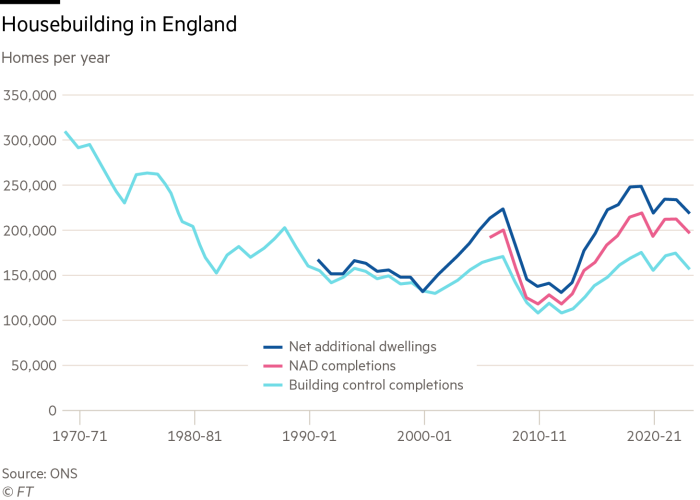The residents of East Lindsey must have got quite a shock last year. According to a census update, there were not, as previous numbers suggested, about 390 homes being built every year in their largely rural Lincolnshire district, which surrounds the seaside resort of Skegness; there were 2,330.
Yet even from the top of The Odyssey — the local amusement park’s tallest rollercoaster — you would have struggled to see any sign of these rafts of new homes: not many cranes peppering the horizon or roads clogged with lorries. No boom in the local population, either. So where are they?
A closer examination of the census data reveals a clue: the recount picked up a large number of static holiday caravans parked near the North Sea coast, which it then added to the housing stock.
It’s not clear whether these holiday caravans account for all the increase or if there was an undercount in earlier data, or some sort of classification issue, but it points to an uncomfortable and often overlooked truth: we don’t really know how many new homes we build every year in the England. And the number depends on whom you ask.

For a government with a clear housebuilding target — 1.5mn new homes by 2029 — this is a problem. And it represents yet another sector, to add to immigration and employment, where the quality of official statistics are pretty dismal.
If you go to the Office for National Statistics website and download its housebuilding data for England, you’ll be following in a long line of politicians, journalists and even housing academics in using data that’s not fit for purpose. Even if you search out the original source — the Ministry of Housing, Communities and Local Government — you’ll end up in a pickle if you click on the wrong link: the most commonly used housebuilding data for this country actually undercounts new-build completions, and by a considerable amount.
The ONS data is largely based on building control figures, a market historically dominated by the National Housebuilding Council (NHBC) — an organisation established to provide warranties on new homes due to concerns about poor build quality in the 1930s. However, in the past couple of decades, NHBC’s market share has deteriorated — from about 85 per cent to about 60 per cent. Though building control data has improved a little since 2017, by making it less reliant on NHBC data, a significant undercount remains.

There is a more robust tally of new homes, which is published as part of the government’s net additional dwellings (NAD) reports. This allows us to understand both the scale and the location of the undercount in the building control data. For example, it shows there were about 158,000 completions across England in the 2023-24 financial year, while the more accurate NAD completions data shows there were 199,000 — a 25 per cent difference, or 40,000, nearly the size of Bath.
The undercount is biggest in areas with a greater variety of housebuilders. While the long-term trend is one of increasing dominance of the big, listed housebuilders, the market has actually become more diverse over the past decade. In many places, there was an increase in activity in everything from small housebuilders and housing associations, to build-to-rent investors and luxury developers — at least until interest rates started rising. And it appears they have been looking elsewhere for their building warranties.
This means, for London, the building control data is severely flawed. For 2023-4, NHBC data shows there were about 16,000 new-build completions, while the NAD figures show there were more than 28,000 — the even more comprehensive Greater London Authority data says there were nearly 32,000 completions. So it appears the building control data is missing nearly half of London’s housebuilding market!

In markets where the traditional volume housebuilders still dominate — for example, suburban developments on the edges of towns, the building control data is still pretty useful. Although, even in places like Milton Keynes, where there has traditionally been a good correlation between the building control and NAD data, there are signs in recent years that it may be failing, as build-to-rent developers and others move in.
England is not the only country that struggles to count how many homes it is building: Ireland has overestimated housing delivery in the past as it relies on electricity connections to count new properties. Cowsheds, outhouses and vacant homes returning to use had contributed to the higher housing delivery figures. When the methodology was revised in 2018, it reduced the number by nearly 58 per cent.
Measuring how many homes we’re building is not just important because of the government’s housing targets (which are actually based on net additions, a measure which includes changes of use and conversions). Understanding who is building new homes and where is essential for ensuring policies are fit for purpose — and not just for hitting targets.
It could also affect your own investments. Increasing numbers of UK pension funds are investing in residential property, particularly through the build-to-rent market. A lack of accurate public information on who is building what and where could lead to their investment not performing as expected. Meanwhile other organisations, including one large, listed housebuilder, still make frequent references to the undercounting Building Control data in London to highlight the large scale of housing undersupply in the capital. The scale of undersupply relative to targets is still substantial but not quite as large as they regularly suggest.

And while the NAD data is a clear improvement on the BC numbers, even this isn’t perfect. It is only published annually and with an eight-month delay. As the GLA data for London shows, the lack of historic revisions prior to 2019-20 means the data probably undercounts completions as some take longer to get registered. We also don’t really know how far back the undercount goes. The late Dr Alan Holmans, an expert on housing statistics, expressed doubts that housing completions in the 1990s — possibly even earlier — were fully recorded.
To deal with missing completions, the NAD data is revised every 10 years when the latest census is released. However, we don’t know whether the missed homes were new build or from some other source and we don’t know what tenure they are or who built them — hence the debacle in East Lindsey, where the number of homes it added to the tally accounted for a third of the national adjustment of 5,890 homes per year for the period between the 2011 and 2021 census.
If nothing else, it shows that if the government really wants to hit its housebuilding target this parliament, maybe it should concentrate on building static holiday caravans outside Skegness.
Neal Hudson is a housing market analyst and founder of the consultancy BuiltPlace











